Why and how to use P.S. lines in emails like a pro in 2025
 Claudia, Community Manager
Claudia, Community Manager
With the average person receiving over 120 emails per day, your subscribers are naturally inclined to scan rather than read. But there’s one section that helps your message stand out in a crowded inbox: the P.S. section in your emails.
The postscript is a powerful yet often undervalued tool for email optimization. While your subject lines and preheaders motivate a person to open your email, the P.S. statement encourages them to respond and act.
Let's explore why this final thought is always read and learn how you can write high-impact P.S. lines in your newsletters to maximize your conversion rates.
What does P.S. mean?
P.S. stands for postscript. It’s an abbreviation taken from the Latin word postscriptum, which translates to "written after."
You’ve definitely seen P.S. lines before, whether in personal emails, formal correspondence, sales pages, or your favorite newsletters.
In the days of handwritten letters, the P.S. served as a quick addendum, saving writers from having to rewrite an entire message if they forgot to include something important.
While modern email apps let us edit easily, the P.S. line's purpose remains the same: to add a final afterthought or, more importantly, to emphasize a certain piece of information.
Here’s what a P.S. looks like in an email:
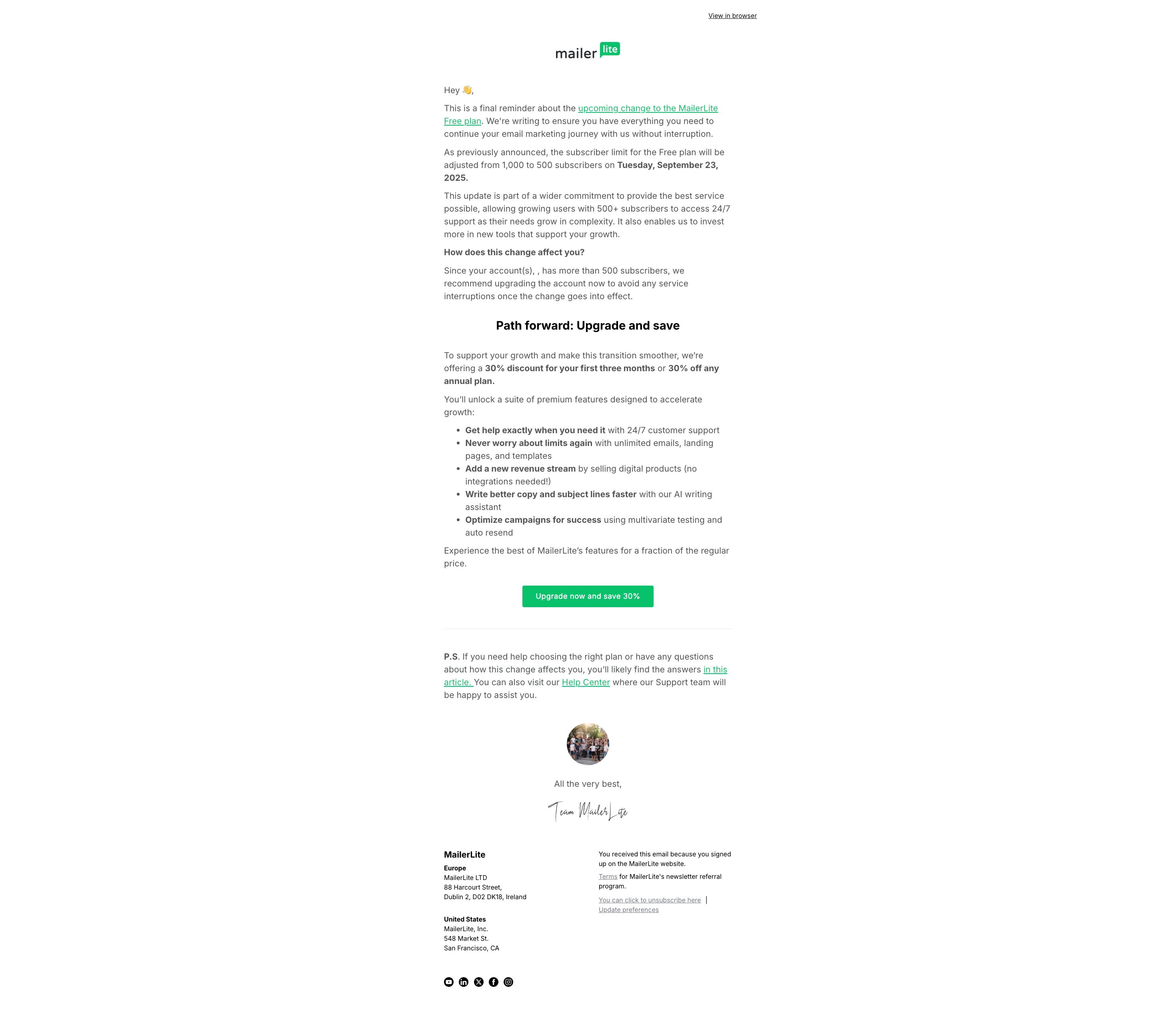
And here’s why it’s important for your email marketing strategy: People tend read the P.S. before they even read the main email body!
That's a pretty compelling reason to consider using this classic copywriting trick for your emails, right? Let's dive deeper into why P.S. lines are so effective and how you can get the maximum benefits in your marketing campaigns.
Why people love reading P.S. lines
The P.S. line is not just a quirky addition, it plays directly into human psychology and reading habits. It works because people instinctively look for the end point, much like how many readers are tempted to check the last page of a book first.
Here are the four key reasons why most people prioritize reading the P.S. in your emails:
1. It’s eye-catching
In a world saturated with information, readers are committed to scanning content to save time. They’re looking for visual anchors. A P.S. line instantly stands out because it's a clearly defined item at the very bottom of the message, giving it a crucial visual advantage.
Human memory reinforces this effect: people tend to remember three parts of a message: the beginning (Primacy), the unusual parts, and the end (Recency). In an email, the P.S. is the ultimate Recency point.
To ensure your P.S. line is unmissable and maximizes conversion rates, always highlight it. You should:
Make the P.S. text bold or italic
Consider formatting the P.S. as a separate, distinct information box or a final call-to-action (CTA) button
In the example below, Lesley (that’s me) chooses to make her P.S. bold so it’s more visible for her readers to notice. They'll see why it's worth giving her pitch a chance.
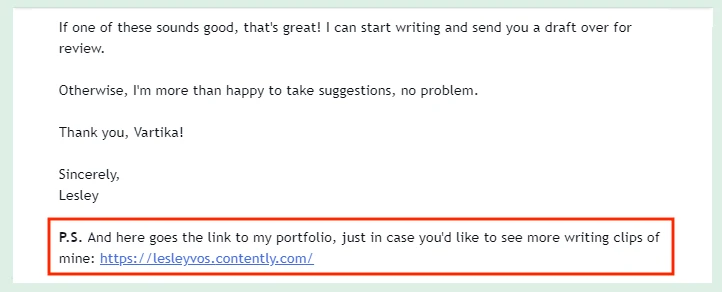
2. It summarizes your content
With attention spans decreasing, only a small percentage of people read an email word-for-word.
People scroll directly to the P.S. line to quickly grasp the gist of the message and decide if the email is worth their time. If the P.S. highlights a key benefit, like a discount, a free resource, or a critical update, it validates their time and prompts them to return to the main body for details.
This means the P.S. is the best place to guarantee visibility for your offer. Always mention the key added value or ultimate takeaway in your P.S. to ensure immediate notice.
3. It adds a personal touch to your emails
In an age where most content feels AI-generated, a well-placed P.S. can immediately offer a sense of humanity and warmth.
The P.S. is traditionally reserved for a personal, final afterthought, making the message feel less like an impersonal marketing broadcast and more like a note from one person to another.
Using an informal or slightly unexpected P.S. can cut through the noise, making the subscriber feel seen or addressed, which can help with engagement and long-term customer loyalty.
4. It leverages the Zeigarnik effect
The Zeigarnik Effect is a psychological principle stating that humans remember incomplete tasks better than completed ones. This creates a mental tension that compels us to finish what we started.
How is this related to emails?
Once opened, an email becomes a task for a person to complete. From there, there are two steps follow:
A user starts reading your email from P.S. because they subconsciously hurry up to complete this action
Your P.S. (depending on how it's written) prompts them to go back and read the whole email to defuse the tension
5. It can act as a strategic call-to-action
From an email optimization standpoint, the P.S. is a valuable real estate for a call-to-action.
Because many of your subscribers will read the P.S. first, placing your primary or secondary CTA here increases its visibility.
Also, it feels less intrusive than repeating the main offer within the body text. It gives the subscriber a clean path to action without being overly aggressive.
6. It's a habit
For many, reading the postscript is simply an ingrained reading habit. Just as some people flip to the end of a magazine first for the quizzes or anecdotes, readers may habitually start from the bottom of an email.
This consistent behavior means you can rely on the P.S. line as the most stable element in your email marketing for capturing reader attention and driving a final click.
How to use P.S. in your marketing emails like a pro
A P.S. can share bonus information, create FOMO (fear of missing out), reiterate a call to action (CTA), or summarize the main email message.
In marketing emails, the P.S. line can explore:
Your prospect's pain point: What they stand to lose.
The solution: What they stand to gain.
The urgency factor: Motivation to act right away (a deadline, a limited number of items you sell, and so on).
And now, let’s explore five ways you can use the P.S. line in your email.
1. Share an extra thought
Given that including a P.S. in your email has a visual advantage and can share something you forgot to mention earlier, you can consider writing an additional thought that helps communicate your central message.
For example, this P.S. from Aaron Orendorff, Head of Marketing at Recart, provides a recap of what he’s been up to. It also includes some quick links to his latest published works. While it doesn't entirely relate to Aaron's central message, it serves as an opportunity to promote his articles.
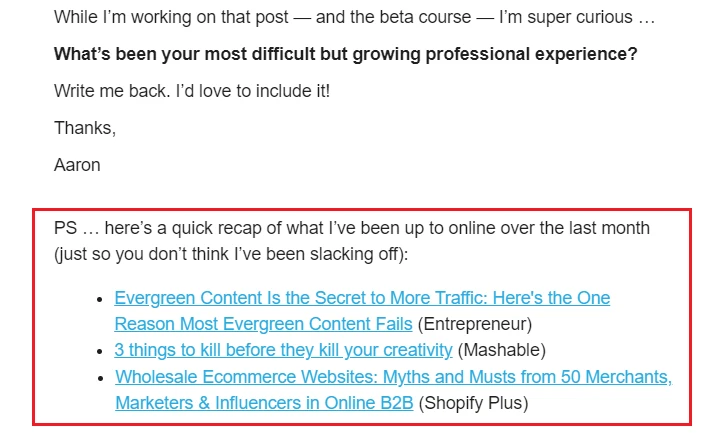
You could also use the P.S. line to let your audience know what they’ll miss if they don't embrace your offer. To motivate them, you can refer to competitors, time saved, or financial incentives.
2. Share bonuses or any other added value
Using P.S. in emails helps people to see whether it's worth spending time reading the whole text. Use it to share additional tips, discounts, freebies, testimonials, reviews, and any other added value to answer your subscribers' WIIFM ("What's in it for me?").
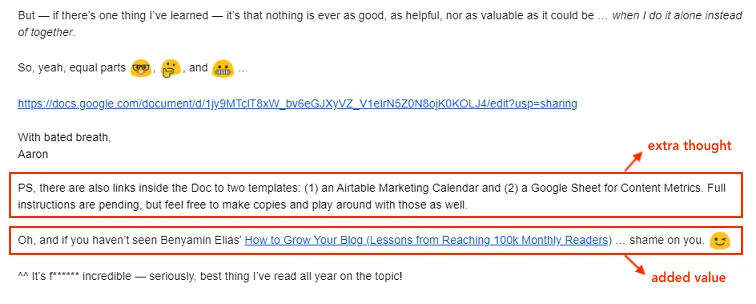
The above P.S. from Aaron Orendorff explains why you need to open the doc he shares in the email body: you'll get something valuable to use in your work further.
He also adds a backlink to an insightful and actionable content piece, leaving people wondering, "Hmm, with so much value already in this P.S., what magical gems will I find in the email itself?"
And indeed, the email itself shared a step-by-step guide to B2B content marketing, with comments from experts and the invitation for receivers to add suggestions and highlight the gaps to make the guide even more valuable.
Consider revising and changing your P.S. every now and then, especially if you send emails to large groups of people using an email marketing service like MailerLite. Keep it different and fresh.
Including a P.S. also allows you to promote limited-time offers, cover various segments of your audience and test which bonuses your prospects love more.
In the below example, Henneke Duistermaat, a copywriting expert and author, nails it by providing a particular segment of her audience with a practical bonus to praise their support.
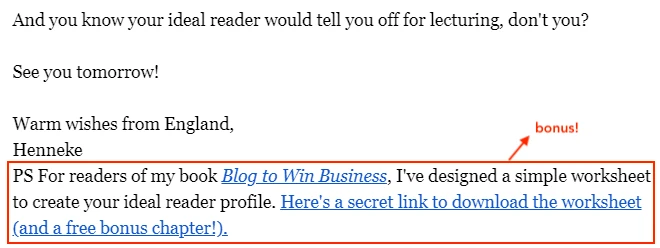
3. Provide a clear call to action
Given the Zeigarnik effect, your email's P.S. seems like an ideal place to add a CTA and invite prospects to take action. It will only spell good news for your email click-through rates!
Look at how Neil Patel has optimized his P.S. so it has a clear CTA link.
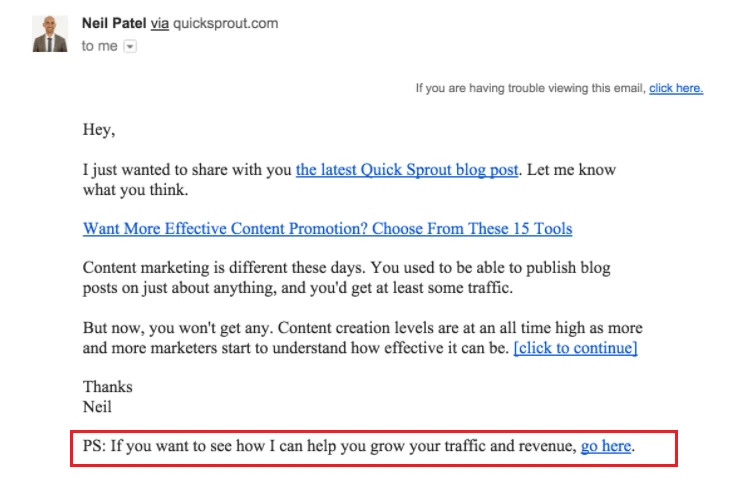
Moreover, you can use P.S. in your emails to share links to your free trials, landing pages, sales pitch videos, or whatever you have. Just make sure you focus on your audience’s pain point and the solution you’re offering.
Inserting a P.S. line after your email sign-off is your last chance to share important links and information. Use this opportunity to say something that adds value to your audience.
In one of their weekly newsletters , MailerLite invited its audience to check out MailerCheck. You can see the use of P.S. in MailerLite’s newsletters pretty often as, according to the team, it generates surprisingly high click rates.
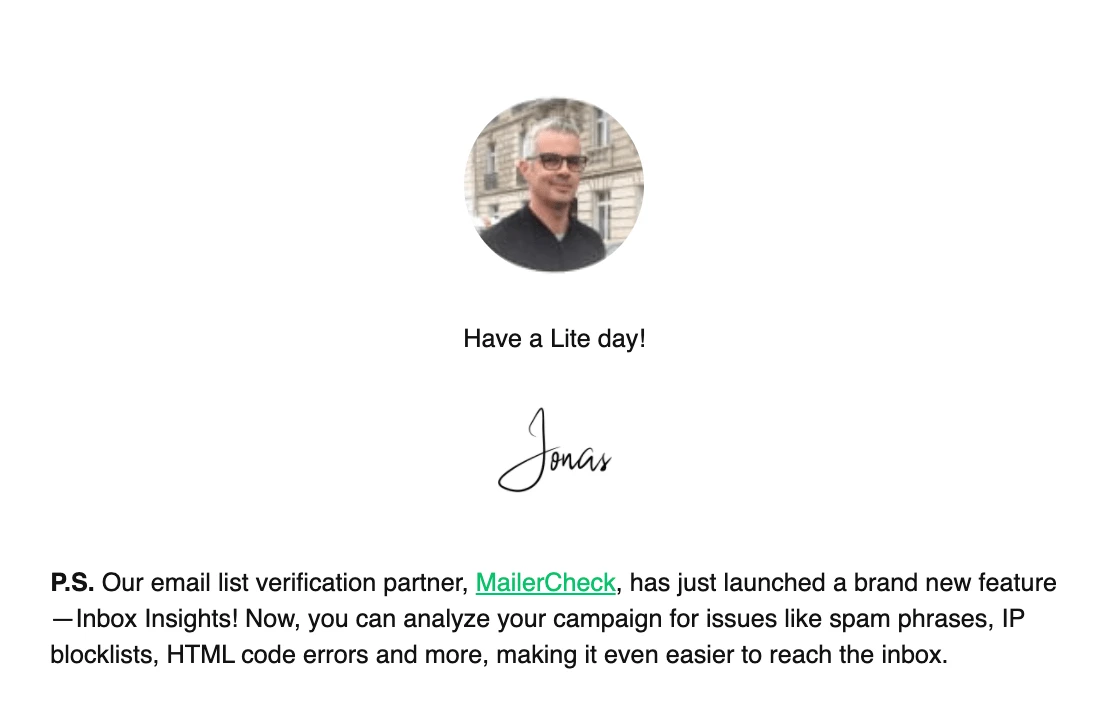
4. Create urgency
Remember, many subscribers will go to your email's P.S. first. (After the subject line, of course.) So this is the space to make some noise!
Try creating urgency in your P.S. line to motivate your subscribers to act.
There are two types of urgency:
1) Time urgency
This sets a deadline to take action.
For example: "A 30% discount is waiting for you if you buy the tickets before April 26". Or “This offer will be available for the first 30 people that sign up” like in the example below, which shows that time is running out fast.
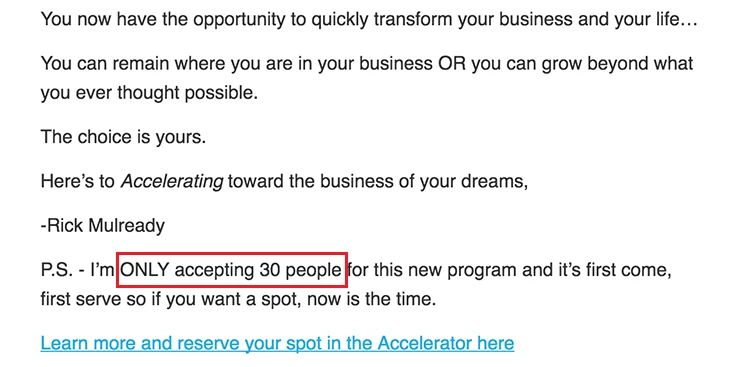
2) Product urgency
This creates a sense of scarcity. Whether you offer a product or service, make it limited and use a P.S. like: "We have only 10 tickets left, so don't miss the chance to get yours!"
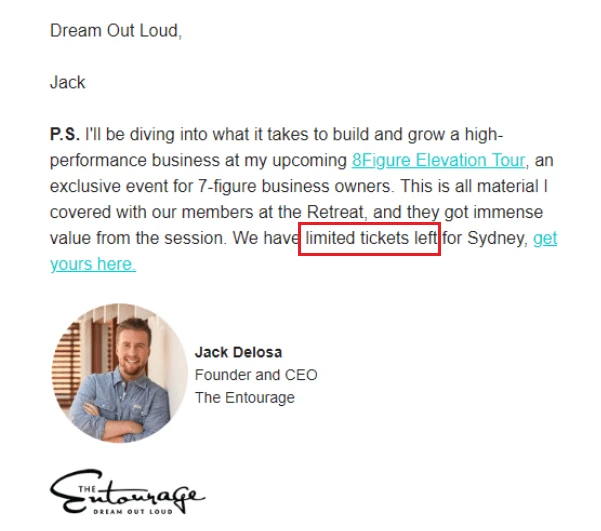
5. Make connections
If your email campaigns are more focused on brand awareness rather than sales, you can use the P.S. line for networking.
For example, encourage people to follow you elsewhere, invite them to join your community, add links to your social media channels, motivate them to subscribe to your side-content, and so on.
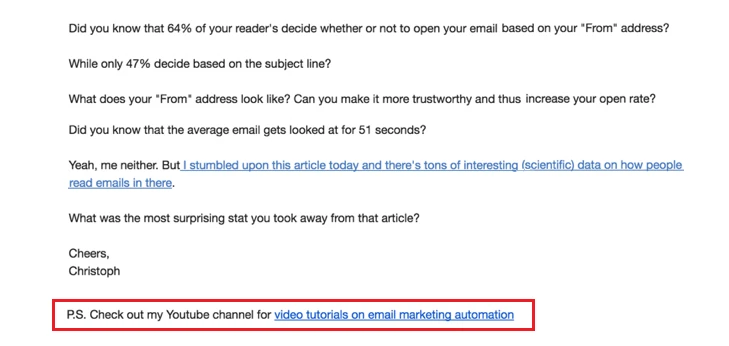
Take this chance to make real connections and grow your network online.
In the example below, Customer Success Growth Expert and Consultant Lincoln Murphy shares upcoming online events where he’ll be a speaker. This offers people the opportunity to register in advance.
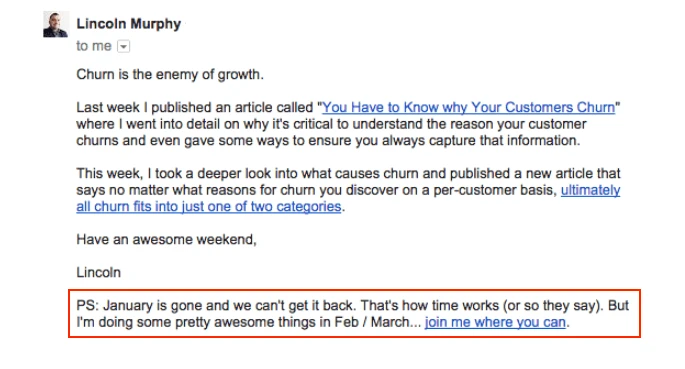
Driving urgency and scarcity: P.S. This 48-hour discount on the Growth Plan ends at midnight tonight—secure your 30% savings now!
Emphasizing financial value (ROI): P.S. Don't forget, customers who implement this feature see an average ROI of 20% in the first quarter. Calculate your potential savings here.
Secondary call-to-action (CTA): P.S. Not ready for the full commitment? You can download our free guide on API rate limits for high-volume sending instead.
Building social proof and trust: P.S. Over 500 of your industry peers have already claimed this template this week. Tap here to join them!
Adding a personal touch: P.S. We genuinely value your feedback. Just hit reply if you have any questions about the new feature, I'll answer personally.
Adding brand personality (for example, humor): P.S. We promise our upcoming webinar is more exciting than watching code compile. Grab your seat before we run out of coffee!
Handling a common objection: P.S. Worried about switching platforms? Our team handles the entire migration process for free. Learn about our effortless onboarding here.
Promoting a content upgrade: P.S. Want a deeper dive into deliverability? We just updated our documentation on DKIM and DMARC setup.
P.S. best practices for 2025: Your 7-point checklist
To master the postscript and turn it into a high-converting tool, you can’t just rely on placement. You need to follow these simple best practices to ensure your P.S. lines are clean, professional, and powerful.
Keep it short and focused: A P.S. should be one or two sentences at most. Anything longer loses its Recency Effect advantage and should be moved into the main body of the email
Use it sparingly and strategically: Overusing the P.S. can dilute its effectiveness and make all your emails look cluttered. Save it for when you truly need to add emphasis or drive a key CTA
Fix the email, not the P.S.: Avoid using a P.S. to include information you simply forgot to mention. It should emphasize a key point, not correct a poorly written message
Adapt based on audience: Use the P.S. with caution in highly formal communications. For informal, conversational, or marketing emails, it is a powerful tool for connection and boosting conversion rates.
Place it after the signature: For maximum visual and psychological impact, always place the P.S. at the very end of the email, separated from your name and sign-off
Always use tracking: You must use tracked links within your P.S. line. This is the only way to measure its superior click-through rate (CTR) against your main body CTAs
A/B test the offer: Don't just place the link; test the content. Run split tests comparing an offer of scarcity (e.g., “Only 10 spots left”) vs. a benefit claim (e.g., “See the 20% ROI calculation”) to see what drives action for your specific audience segment
P.S. One last thing…
The P.S. line is a perfect email element to add a personal touch to your messages and build stronger relationships. Use it to deliver the right message to different segments of your target audience, boost their trust and build loyalty to your brand.
You can take it a step further and call a subscriber by name in your P.S. for even more authenticity and personalization. Using a P.S. in your email will make your marketing message sound more human and inspire your subscribers to take action!

Lesley is a savvy writer and content strategist. Currently blogging at Bid4Papers website, she also contributes to publications on digital marketing and sales copywriting. Her background helps writers develop the confidence and skills for better content creation and promotion.
